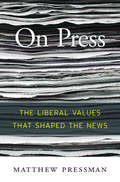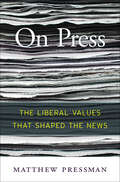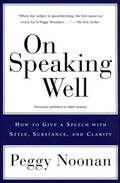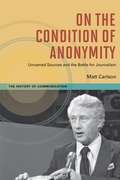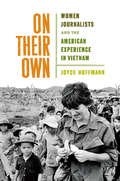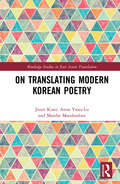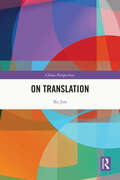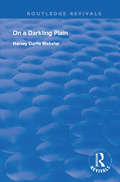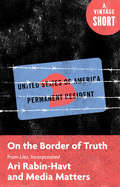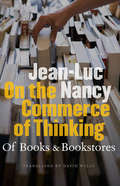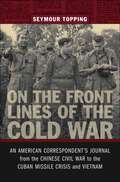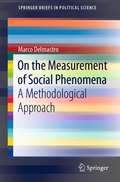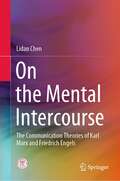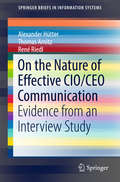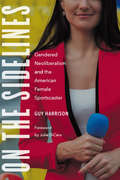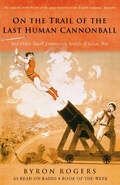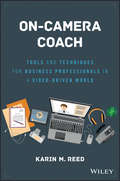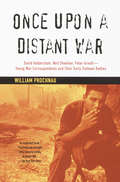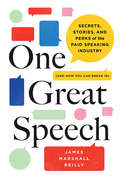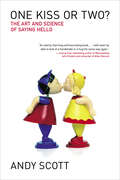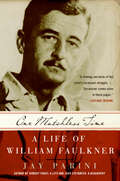- Table View
- List View
On Press: The Liberal Values That Shaped the News
by Matthew PressmanAs Matthew Pressman’s timely history reveals, during the turbulent 1960s and 70s the core values that held the news industry together broke apart and the distinctive characteristics of contemporary American print journalism emerged. Simply reporting the facts was no longer enough as reporters recognized a need to interpret events for their readers.
On Press: The Liberal Values That Shaped the News
by Matthew PressmanA study of how mainstream journalism transformed from 1960 to 1980.In the 1960s and 1970s, the American press embraced a new way of reporting and selling the news. The causes were many: the proliferation of television, pressure to rectify the news media’s dismal treatment of minorities and women, accusations of bias from left and right, and the migration of affluent subscribers to suburbs. As Matthew Pressman’s timely history reveals, during these tumultuous decades the core values that held the profession together broke apart, and the distinctive characteristics of contemporary American journalism emerged.Simply reporting the facts was no longer enough. In a country facing assassinations, a failing war in Vietnam, and presidential impeachment, reporters recognized a pressing need to interpret and analyze events for their readers. Objectivity and impartiality, the cornerstones of journalistic principle, were not jettisoned, but they were reimagined. Journalists’ adoption of an adversarial relationship with government and big business, along with sympathy for the dispossessed, gave their reporting a distinctly liberal drift. Yet at the same time, “soft news”—lifestyle, arts, entertainment—moved to the forefront of editors’ concerns, as profits took precedence over politics.Today, the American press stands once again at a precipice. Accusations of political bias are more rampant than ever, and there are increasing calls from activists, customers, advertisers, and reporters themselves to rethink the values that drive the industry. As On Press suggests, today’s controversies—the latest iteration of debates that began a half-century ago—will likely take the press in unforeseen directions and challenge its survival.Praise for On Press“The ultimate story behind all the stories. In tracing the evolution of news over the past half century, Matthew Pressman has produced an account that’s deeply historical and not a little troubling. In an age when the press is alternately villain or hero, Pressman serves as a kind of medicine man of journalism, telling us how we got from there to here and warning us what must change.” —Graydon Carter, former editor of Vanity Fair“Pressman helps us understand how we came to our current, troubled media moment with his deeply researched, engagingly written history of America’s press in the 1960s and ’70s. This is an important and original contribution—and a needed one.” —Margaret Sullivan, media columnist for the Washington Post
On Secrets
by Annika SmethurstOn June 4, Federal Police raided the home of Walkley award-winning journalist Annika Smethurst, changing her life forever.Police claim they were investigating the publication of classified information, her employer called it a 'dangerous act of intimidation', Smethurst believes she was simply doing her job.Smethurst became the accidental poster woman for press freedom as politicians debated the merits of police searching through her underwear drawer. In On Secrets she will discuss the impact this invasion has had on her life, and examine the importance of press freedom.
On Smaller Dogs and Larger Life Questions
by Kate FigesComing up to her sixtieth birthday, Kate Figes found herself turning to the larger questions of family, love and life's meaning. It is like this author to examine different stages in writing, and her books - from new motherhood and adolescence to coupledom and infidelity - testify to this way of understanding herself and others: so naturally she turned to writing to explore the challenges of becoming sixty. And then - a horrible, and sudden diagnosis of breast cancer which had metastasised.Instead of a gentle journey into middle age, Kate Figes began to write for her life. Now, clawing back confidence and control was not just the ordinary business of these years: it was the only way to try and survive great pain and emotional turmoil. As her writing became an honest reflection on ageing, failing, regrets and the importance of childhood memory, friends, family and love she found a new determination to live to the full and about finding ways to face up to a shortened life expectancy with dignity.Original, passionate, funny and moving, On Smaller Dogs and Larger Life Questions will resonate with anyone dealing with the many griefs and freedoms of midlife. It is about living with a life-threatening disease but it is even more: an intelligent and passionate look at the way we can approach disappointment and trouble, friendship and love - every day.
On Speaking Well: How to Give a Speech with Style, Substance, and Clarity
by Peggy NoonanA presidential speechwriter offers practical wisdom and insightful tips in this authoritative guide to writing and giving a speech.For anyone who fears the thought of writing and giving a speech—be it to business associates, or at a wedding—help is at hand. Acclaimed presidential speechwriter Peggy Noonan shares her secrets to becoming a confidence, persuasive speaker demystifying topics including:Finding you own authentic voiceDeveloping a text that interests youAcing the all-important first paragraphUsing logic to move your audienceCreating, developing, and reinventing the “core speech” for diverse audiencesStrengthening your speech with a vital element: humorWinnowing your thoughts down to the essentialsHandling professional jargon, clichés, and the sound bite syndromeRespecting simplicity and clarity—big ideas need small wordsPresenting your speech in the best wayCollecting intellectual income—conversing your speech treasuresBreaking all the rules and still succeedingReading for inspiration—how to use the excellence of othersComplete with lessons, tips and memorable examples, On Speaking Well shows us how to create forceful, persuasive, relevant speeches that will resonate with our audiences. Engaging, informative, and always entertaining, this is undoubtedly the authoritative how-to guide for anyone writing or giving a speech.
On The Condition of Anonymity
by Matt CarlsonMatt Carlson confronts the promise and perils of unnamed sources in this exhaustive analysis of controversial episodes in American journalism during the George W. Bush administration, from prewar reporting mistakes at the New York Times and Washington Post to the Valerie Plame leak case and Dan Rather's lawsuit against CBS News. Weaving a narrative thread that stretches from the uncritical post-9/11 era to the spectacle of the Scooter Libby trial, Carlson examines a tense period in American history through the lens of journalism. Revealing new insights about high-profile cases involving confidential sources, he highlights contextual and structural features of the era, including pressure from the right, scrutiny from new media and citizen journalists, and the struggles of traditional media to survive amid increased competition and decreased resources.
On Their Own: Women Journalists and the American Experience in Vietnam
by Joyce HoffmanOver three hundred women, both print and broadcast journalists, were accredited to chronicle America’s activities in Vietnam. Many of those women won esteemed prizes for their reporting, including the Pulitzer, the Overseas Press Club Award, the George Polk Award, the National Book Award, and the Bancroft Prize for History. <P><P>Tragically, several lost their lives covering the war, while others were wounded or taken prisoner. In this gripping narrative, veteran journalist Joyce Hoffmann tells the important yet largely unknown story of a central group of these female journalists, including Dickey Chapelle, Gloria Emerson, Kate Webb, and others. Each has a unique and deeply compelling tale to tell, and vivid portraits of their personal lives and professional triumphs are woven into the controversial details of America’s twenty-year entanglement in Southeast Asia.
On Translating Modern Korean Poetry
by Jieun Kiaer Anna Yates-Lu Mattho ManderslootOn Translating Modern Korean Poetry is a research monograph exploring the intricacies and complexities of translating modern Korean poetry. This monograph highlights the difficulties entailed in translating Korean poetry, due to the lexical, structural, social, expressive and attitudinal levels with which the translator must be engaged. Featuring all-new translations, this book explores the question of what exactly modern Korean poetry is, increases the representation of female poets and includes poems addressing modern historical events, globalization, diaspora and mental health. Each chapter provides commentary on both the original and translated texts and looks at some of the issues that arose during the translation process. By doing so the authors draw attention to the intricate, trans-cultural and trans-creational process of Korean poetry translation. Collating contemporary Korean poetry and intricately exploring the translation process, this book is ideal for researchers and advanced level students of Korean Studies, Translation Studies and Literature with an interest in translation.
On Translation (China Perspectives)
by Xu JunThis book presents a fresh perspective on translation, exploring it as a complex process of cultural exchange involving both language and culture.The author examines the core aspects of translation, including its nature and procedures, key factors, text selection and approaches. It also examines the internal tensions and dynamics between authors, translators and readers, and the value system of translation criticism. The book also illustrates the role of culture in translation, discussing the cultural information embedded in language, the relationship between culture and meaning, the cultural interpretation of meaning and texts, the intersection of translation and cultural psychology, and the principles and methods of translation studies from a cultural perspective. By developing a systematic theoretical framework, the book aims to present translation as a complex facet of intercultural communication.This insightful work will appeal to scholars, students, translators and anyone interested in translation theory, translation studies and intercultural communication.
On a Darkling Plain (Routledge Revivals)
by Harvey Curtis WebsterOriginally published in 1947 and presenting the famed poet-novelist against the background of contemporary thought and society, Harvey Curtis Webster shows that Hardy's later works give consistent evidence of hope; that pervasive pessimism was by no means the keynote of Hardy's thought. On a Darkling Plain traces the evolution of Hardy's thought, from faith, through disillusionment, to a cautious belief in the ultimate progress of man.
On the Border of Truth: From Lies, Incorporated (A Vintage Short)
by Media Matters for America Ari Rabin-HavtIn a post-truth political landscape, there is a carefully concealed but ever-growing industry of organized misinformation that exists to create and disseminate lies in the service of political agendas. This is especially true today for immigration reform, which has become severely limited under President Trump’s first term in office and affecting millions of people’s lives. livelihoods and families. Scrutinizing the dangerous misinformation purveyed by organizations like John Tanton’s The Center of Immigration Studies and others, On the Border of Truth is a powerful look at the organizations and people that have been pushing a coordinated assault on truth for years before the 2016 election. A Vintage Shorts Selection. An ebook short.
On the Commerce of Thinking: Of Books and Bookstores
by Jean-Luc NancyJean-Luc Nancy's On the Commerce of Thinking concerns the particular communication of thoughts that takes place by means of the business of writing, producing, and selling books. His reflection is born out of his relation to the bookstore, in the first place his neighborhood one, but beyond that any such "perfumery, rotisserie, patisserie," as he calls them, dispensaries "of scents and flavors through which something like a fragrance or bouquet of the book is divined, presumed, sensed." On the Commerce of Thinking is thus not only something of a semiology of the specific cultural practice that begins with the unique character of the writer's voice and culminates in a customer crossing the bookstore threshold, package under arm, on the way home to a comfortable chair, but also an understated yet persuasive plea in favor of an endangered species. In evoking the peddler who, in times past, plied the streets with books and pamphlets literally hanging off him, Nancy emphasizes the sensuality of this commerce and reminds us that this form of consumerism is like no other, one that ends in an experience-reading-that is the beginning of a limitless dispersion, metamorphosis, and dissemination of ideas. Making, selling, and buying books has all the elements of the exchange economy that Marx analyzed--from commodification to fetishism--yet each book retains throughout an absolute and unique value, that of its subject. With reading, it gets repeatedly reprinted and rebound. For Nancy, the book thus functions only if it remains at the same time open and shut, like some Moebius strip. Closed, it represents the Idea and takes its place in a canon by means of its monumental form and the title and author's name displayed on its spine. But it also opens itself to us, indeed consents to being shaken to its core, in being read each time anew.
On the Front Lines of the Cold War: An American Correspondent's Journal from the Chinese Civil War to the Cuban Missile Crisis and Vietnam (From Our Own Correspondent)
by Seymour ToppingIn the years following World War II, the United States suffered its most severe military and diplomatic reverses in Asia while Mao Zedong laid the foundation for the emergence of China as a major economic and military world power. As a correspondent for the International News Service, the Associated Press, and later for the New York Times, Seymour Topping documented on the ground the tumultuous events during the Chinese Civil War, the French Indochina War, and the American retreat from Vietnam, Cambodia, and Laos. In this riveting narrative, Topping chronicles his extraordinary experiences covering the East-West struggle in Asia and Eastern Europe from 1946 into the 1980s, taking us beyond conventional historical accounts to provide a fresh, first-hand perspective on American triumphs and defeats during the Cold War era.At the close of World War II, Topping -- who had served as an infantry officer in the Pacific -- reported for the International News Service from Beijing and Mao's Yenan stronghold before joining the Associated Press in Nanking, Chiang Kai-shek's capital. He covered the Chinese Civil War for the next three years, often interviewing Nationalist and Communist commanders in combat zones. Crossing Nationalist lines, Topping was captured by Communist guerrillas and tramped for days over battlefields to reach the People's Liberation Army as it advanced on Nanking. The sole correspondent on the battlefield during the decisive Battle of the Huai-Hai, which sealed Mao's victory, Topping later scored a world-wide exclusive as the first journalist to report the fall of the capital. In 1950, Topping opened the Associated Press bureau in Saigon, becoming the first American correspondent in Vietnam. In 1951, John F. Kennedy, then a young congressman on a fact-finding visit to Saigon, sought out Topping for a briefing. Assignments in London and West Berlin followed, then Moscow and Hong Kong for the New York Times. During those years Topping reported on the Chinese intervention in the Korean conflict, Mao's Cultural Revolution and its preceding internal power struggle, the Chinese leader's monumental ideological split with Nikita Khrushchev, the French Indochina War, America's Vietnam War, and the genocides in Cambodia and Indonesia. He stood in the Kremlin with a vodka-tilting Khrushchev on the night the Cuban missile crisis ended and interviewed Fidel Castro in Havana on its aftermath.Throughout this captivating chronicle, Topping also relates the story of his marriage to Audrey Ronning, a world-renowned photojournalist and writer and daughter of the Canadian ambassador to China. As the couple traveled from post to post reporting on some of the biggest stories of the century in Asia and Eastern Europe, they raised five daughters. In an epilogue, Topping cites lessons to be learned from the Asia wars which could serve as useful guides for American policymakers in dealing with present-day conflicts in Afghanistan and Iraq.From China to Indochina, Burma to Korea and beyond, Topping did more than report the news; he became involved in international diplomacy, enabling him to gain extraordinary insights. In On the Front Lines of the Cold War, Topping shares these insights, providing an invaluable eyewitness account of some of the pivotal moments in modern history.
On the Measurement of Social Phenomena: A Methodological Approach (SpringerBriefs in Political Science)
by Marco DelmastroThis book explores the analysis of social phenomena, using a multidisciplinary approach while addressing statistical, economic, sociological, as well as psychological issues.The author presents a detailed account of the procedures and techniques used to gather, process, and analyze data. Topics covered include, but are not limited to survey data, content analysis data, data visualization, as well as data about crimes.The book addresses this methodological framework that drives applied social sciences in an applicative and simple way, by analyzing key social phenomena such as the threats to journalism, the so-called chilling effect, and the market for news. Finally, the author examines the data and measures of the recent COVID-19 pandemic.This book is a must-read for everybody interested in a better understanding of the methodological analysis of social phenomena, social and political methodology, and applied science in general.
On the Mental Intercourse: The Communication Theories of Karl Marx and Friedrich Engels
by Lidan ChenThis book meticulously examines the works of Karl Marx and Friedrich Engels (including numerous letters) to present their thoughts on communication and media studies from the perspective of “world intercourse” to reveal their spread in all areas of social information dissemination of ideas. The scope of the book ranges from language, writing and printing to newspapers, and from religion, literature and art, public opinion, and publicity to news, the communication revolution, communication policy, communication psychology, and the free exchanges of workers in the party. It is intended for readers with a college degree or above, especially those concerned about the dissemination of information and social interaction as well as intercourse.
On the Nature of Effective CIO/CEO Communication
by René Riedl Alexander Hütter Thomas ArnitzThis book examines the effectiveness of communication between chief information officer (CIO) and chief executive officer (CEO) and its impact on the role of information technology (IT) in an organization. The book is empirically based on interviews with CIO/CEO pairs from twelve organizations in the manufacturing and retail industries. It examines how CIOs and CEOs can achieve effectiveness in their communication, including insights into antecedents and consequences of communication effectiveness. Based on the interview data the authors develop a CIO/CEO communication model with which CIOs and CEOs can gain new insights into the efficiency of their interactions, likely resulting in higher levels of shared understanding regarding the role of IT in their organization.
On the Sidelines: Gendered Neoliberalism and the American Female Sportscaster (Sports, Media, and Society)
by Guy HarrisonWhen sports fans turn on the television or radio today, they undoubtedly find more women on the air than ever before. Nevertheless, women sportscasters are still subjected to gendered and racialized mistreatment in the workplace and online and are largely confined to anchor and sideline reporter positions in coverage of high-profile men&’s sports. In On the Sidelines Guy Harrison weaves in-depth interviews with women sportscasters, focus groups with sports fans, and a collection of media products to argue that gendered neoliberalism—a cluster of exclusionary twenty-first-century feminisms—maintains this status quo. Spinning a cohesive narrative, Harrison shows how sportscasting&’s dependence on gendered neoliberalism broadly places the onus on women for their own success despite systemic sexism and racism. As a result, women in the industry are left to their own devices to navigate double standards, bias in hiring and development for certain on-air positions, harassment, and emotional labor. Through the lens of gendered neoliberalism, On the Sidelines examines each of these challenges and analyzes how they have been reshaped and maintained to construct a narrow portrait of the ideal neoliberal female sportscaster. Consequently, these challenges are taken for granted as &“natural,&” sustaining women&’s marginalization in the sportscasting industry.
On the Trail of the Last Human Cannonball: And Other Small Journeys in Search of Great Men
by Byron RogersFrom “a great journalist of the older school,” travel essays chronicling the author’s search for incredible stories about extraordinary people (The Guardian).Byron Rogers’ latest collection of travel pieces follows the winning formula of his previous book, An Audience with an Elephant, as he goes in search of a remarkable array of quirky, whimsical, and singular individuals. But in addition to meeting a pensioner on a holiday who decided to swim across the Amazon, this book sees Rogers meeting a number of undeniably famous people. But as one might expect, Rogers’ encounters with celebrity have their own unexpected outcomes. Burt Lancaster rants to him about transsexuality, Rita Hayworth is most worried about her neighbor’s TV aerial, and a retired star of the silent screen turns out to live in Henley-on-Thames.“It is with the delicacy and determination of an archaeologist—and the wit of a publican and far-sightedness of a dreamer—that Rogers excavates people and places.” —Daily Telegraph“A wonderful writer. Droll, poignant and dreamy.” —New Statesman
On-Camera Coach: Tools and Techniques for Business Professionals in a Video-Driven World
by Karin M. ReedThe invaluable handbook for acing your on-camera appearance On-Camera Coach is your personal coach for becoming great on camera. From Skype interviews and virtual conferences to shareholder presentations and television appearances, this book shows you how to master the art of on-camera presentation to deliver your message clearly, effectively, and with confidence. Fear of public speaking is common, but even the most seasoned speakers freeze in front of a single lens—being on camera demands an entirely new set of skills above and beyond the usual presentation to an audience you can actually see. It requires special attention to the way you move, the way you speak, and even the way you dress. This book provides the guidance and tools you need to ace it every time. Video is powerful, and it is everywhere; corporate YouTube channels, webinars, virtual meetings, TedTalks, and more are increasingly turning the lens on those who typically remain behind the scenes. This relatively recent trend will continue to expand as media plays a larger role in business, and the ability to appear confident, authoritative, and polished is becoming a necessary job skill. This book shows you everything you need to know about being on camera, from preparation through presentation and beyond. Learn how to prepare for an on-camera appearance Tailor your presentation to on-camera demands Discover how the camera interprets wardrobe and body language Appear dynamic, confident, and engaged when the lens points your way The lens captures everything—the awkward pauses, the nervous fidgets, poor posture, and every false start and mistake is captured for posterity. Is that the image you want to present? You want to get your message across and be heard; to do that, you must portray authority, energy, and confidence—even when you don't feel it. On-Camera Coach provides the expert instruction and insider secrets that help you make your message sing.
Once I Was You: A Memoir (Atria Espanol Ser.)
by Maria HinojosaNPR&’s Best Books of 2020 BookPage&’s Best Books of 2020 Real Simple&’s Best Books of 2020 Boston.com readers voted one of Best Books of 2020 &“Anyone striving to understand and improve this country should read her story.&” —Gloria Steinem, author of My Life on the Road The Emmy Award–winning journalist and anchor of NPR&’s Latino USA tells the story of immigration in America through her family&’s experiences and decades of reporting, painting an unflinching portrait of a country in crisis in this memoir that is &“quite simply beautiful, written in Maria Hinojosa&’s honest, passionate voice&” (BookPage).Maria Hinojosa is an award-winning journalist who, for nearly thirty years, has reported on stories and communities in America that often go ignored by the mainstream media—from tales of hope in the South Bronx to the unseen victims of the War on Terror and the first detention camps in the US. Bestselling author Julia Álvarez has called her &“one of the most important, respected, and beloved cultural leaders in the Latinx community.&” In Once I Was You, Maria shares her intimate experience growing up Mexican American on the South Side of Chicago. She offers a personal and illuminating account of how the rhetoric around immigration has not only long informed American attitudes toward outsiders, but also sanctioned willful negligence and profiteering at the expense of our country&’s most vulnerable populations—charging us with the broken system we have today. An urgent call to fellow Americans to open their eyes to the immigration crisis and understand that it affects us all, this honest and heartrending memoir paints a vivid portrait of how we got here and what it means to be a survivor, a feminist, a citizen, and a journalist who owns her voice while striving for the truth. Also available in Spanish as Una vez fui tú.
Once Upon a Distant War: David Halberstam, Neil Sheehan, Peter Arnett--Young War Correspondents and Their Early Vientnam Battles
by William ProchnauOnce Upon a Distance War tells the stories of such young Vietnam war correspondents as Neil Sheehan, Peter Arnett, and David Halberstam, providing a riveting chronicle of high adventure and brutal slapstick, gallantry and cynicism, as well as a vital addition to the history they shaped. "Prochnau . . . tells a Vietnam story we haven't heard before. . . . Complex, witty, and humane."--Tobias Wolff. of photos.
One Great Speech: Secrets, Stories, and Perks of the Paid Speaking Industry (And How You Can Break In)
by James Marshall ReillyTell your story, change your lifeThink about people who are paid to speak at events. They're all celebrities, former politicians, or award-winning experts in their fields, right? Wrong. The truth is that every year, thousands of ordinary people generate five- and even six-figure incomes—just from speaking. And you can too.With the right know-how, anyone can harness the power of their own story to carve out a lucrative speaking career. Listen in as veteran speaking agent James Marshall Reilly shares insider knowledge and tells compelling stories about dozens of successful speakers. Packed with clearly defined strategies and techniques, this book offers the tips and information you'll need to be well positioned for success as a paid speaker, including how to:Identify, hone, and frame your personal story—or message—so other people will pay to hear itCreate compelling marketing materials and get an agentWork with that agent to develop a personal brand and own your nicheIncrease your speaking fees over time, interact with audiences, and handle failureUse paid speeches to sell an idea, attract customers, build your profile, and generate revenue for your business or nonprofitOne Great Speech is the only resource written by an insider that details the ins and outs of the paid speaking industry. It is the essential blueprint for finding that one great speech that will lead you to speaking success.
One Kiss or Two?: The Art and Science of Saying Hello
by Andy Scott&“[An] enlightening survey of greeting customs from around the world . . . [a] breezy mix of pop sociology, personal anecdote, and self-help.&” —Publishers Weekly Humans have been greeting each other for thousands of years. It should be the most straightforward thing in the world, but this seemingly simple act is fraught with complications, leading to awkward misunderstandings, intercultural fumblings, and social gaffes that can potentially fracture relationships forever. Why is that? Why are greetings so important? Is there a right and wrong way to say hello? In his illuminating book One Kiss or Two?, Andy Scott—a well-traveled former diplomat and no stranger to botched first contacts himself—takes a closer look at what greetings are all about. In discovering how they have developed over human history, he uncovers a kaleidoscopic world of etiquette, body-language, evolution, neuroscience, anthropology, and history. Through in-depth research and his personal experiences, and with the help of experts ranging from the world-famous primatologist Jane Goodall to the leading sociologist of the twentieth century Erving Goffman, Scott takes readers on a captivating journey through a subject far richer than we might have expected. By the end of it, we are able to make more sense of what lies behind greetings—and what it means to be human in the modern, cross-cultural age. &“Scott speculates on the origins of the cheek-kissing tradition . . . and how to avoid a social faux pas no matter where you are.&” —Conde Nast Traveler &“An utterly charming and fascinating book. I will never be able to look at a handshake or a hug the same way again.&” —Joshua Foer, New York Times–bestselling author
One Matchless Time: A Life of William Faulkner
by Jay PariniWilliam Faulkner was a literary genius, and one of America's most important and influential writers. Drawing on previously unavailable sources -- including letters, memoirs, and interviews with Faulkner's daughter and lovers -- Jay Parini has crafted a biography that delves into the mystery of this gifted and troubled writer. His Faulkner is an extremely talented, obsessive artist plagued by alcoholism and a bad marriage who somehow transcends his limitations. Parini weaves the tragedies and triumphs of Faulkner's life in with his novels, serving up a biography that's as engaging as it is insightful.
One Nation, Many People, Volume 1: The United States to 1900
by GlobeStudents of all ability levels can access the dramatic human story of our nation's diverse and compelling history. The inclusive, culturally diverse perspective - along with graphs, illustrations, and timelines of main events and dates - makes history relevant and exciting for students.
